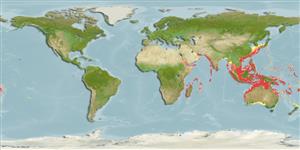Actinopterygii (ray-finned fishes) >
Tetraodontiformes (Puffers and filefishes) >
Tetraodontidae (Puffers) > Tetraodontinae
Etymology: Lagocephalus: Greek, lagos = hare + Greek, kephale = head (Ref. 45335).
Environment / Climate / Range
Ecology
Marine; brackish; demersal; oceanodromous (Ref. 51243). Subtropical, preferred ?
Indo-West Pacific: Red Sea, South Africa, Australia. Introduced (Lessepsian) in eastern Mediterranean, Israel, Lebanon, Iskenderun, Mersin, Aegean Sea.
Size / Weight / Age
Maturity: Lm ? range ? - ? cm
Max length : 37.4 cm TL male/unsexed; (Ref. 96317); 43.1 cm TL (female); common length : 25.0 cm TL male/unsexed; (Ref. 5450)
Essentially an inhabitant of marine waters, but enters the mouths of rivers (Ref. 4833). Several organs are very toxic, potentially lethal to humans (Ref. 43448).
Life cycle and mating behavior
Maturity | Reproduction | Spawning | Eggs | Fecundity | Larvae
Tortonese, E., 1979. Tetraodontidae. p. 645-646. In J.C. Hureau and Th. Monod (eds.) Check-list of the fishes of the north-eastern Atlantic and of the Mediterranean (CLOFNAM). UNESCO, Paris. Vol. 1. (Ref. 2730)
IUCN Red List Status (Ref. 115185)
CITES (Ref. 94142)
Not Evaluated
Threat to humans
Harmless
Human uses
Fisheries: of no interest
More information
ReferencesAquacultureAquaculture profileStrainsGeneticsAllele frequenciesHeritabilityDiseasesProcessingMass conversion
Tools
Special reports
Download XML
Internet sources
Estimates of some properties based on models
Phylogenetic diversity index (Ref.
82805): PD
50 = 0.5005 [Uniqueness, from 0.5 = low to 2.0 = high].
Bayesian length-weight: a=0.01995 (0.01440 - 0.02764), b=2.88 (2.82 - 2.94), in cm Total Length, based on LWR estimates for this species (Ref.
93245).
Trophic Level (Ref.
69278): 3.7 ±0.4 se; Based on size and trophs of closest relatives
Resilience (Ref.
69278): Medium, minimum population doubling time 1.4 - 4.4 years (Preliminary K or Fecundity.).
Vulnerability (Ref.
59153): Low to moderate vulnerability (31 of 100) .
